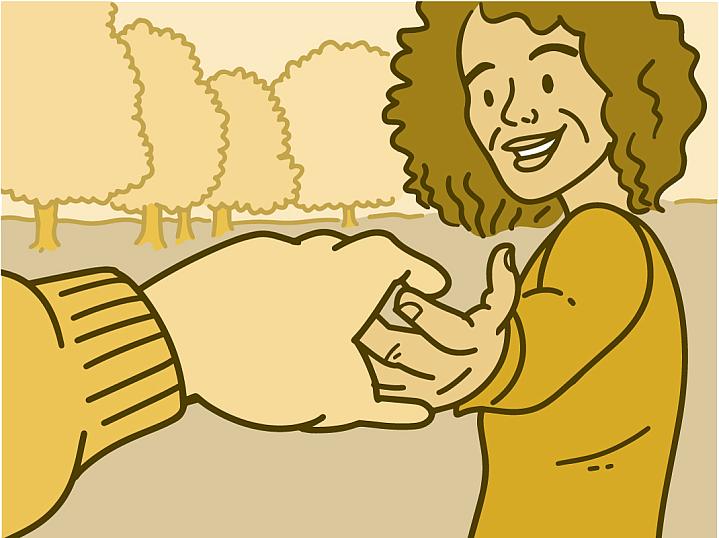Trouble With Touch?
Feeling Your World

Your senses let you experience the world. Sight, hearing, taste, or even smell may be the first sense to spring to mind*. But don’t forget touch. Your sense of touch helps keep you safe from physical threats and can strengthen social bonds. It can also be altered by many health conditions.
“Your skin is your largest sensory organ by far,” says Dr. Alexander Chesler, a touch researcher at NIH. “It encompasses your entire body. And the precision, accuracy, and speed at which it can sense touch is absolutely extraordinary.”
Feeling too little or too much sensation from touch can affect your quality of life. Over the last decade, researchers have made major progress in understanding how touch works. They’re now using this information to help address pain and other conditions where your sense of touch can turn against you.
From Pleasure to Pain
Nerve cells in your skin are the first to sense when you touch something. They send electrical impulses to your spinal cord, which then passes the signal on to your brain.
Each nerve cell can respond with a different level of sensitivity to different types of sensations. Some nerve cells in the skin sense things that hurt, like a pinch or a sharp object. Others pick up sensations like hot, cold, or the burning feel of spicy foods, like a chili pepper. Your skin is also coated in nerve endings that sense different types of force, like pressure or being stretched.
Researchers are just beginning to uncover the way pressure-sensing nerve cells affect how sensations are felt throughout the body, and what happens if they’re damaged. For example, researchers recently discovered a protein that triggers the sensation of gentle touch. It’s called PIEZO2. People born with a rare condition in which they lack PIEZO2 struggle to feel certain types of light sensations on their skin, like vibrations. They also have trouble sensing how their body is positioned when their eyes are closed.
Chesler and other researchers have found that PIEZO2 also plays a role in sexual sensation. The protein is found in many organs inside the body, too. Researchers now are trying to figure out what these touch receptors do internally. For example, they may help trigger the urge to urinate by sensing pressure in a full bladder.
“Touch is really about the skin. But if you look underneath the skin, there’s a range of mechanical forces that you feel in every single tissue of your body,” Chesler explains.
Researchers have found that the signal PIEZO2 sends to the brain can sometimes go haywire. In a condition called tactile allodynia, the sensation of gentle touch turns painful. One example is when your skin gets damaged, like with a sunburn. The pain usually goes away after the skin heals. But for some people it doesn’t, and they experience chronic pain.
“We’ve found that PIEZO2 is absolutely essential for generating this type of pain,” Chesler says. His team is searching now for drugs that could potentially block PIEZO2 at the skin while allowing it to work elsewhere in the body.
From Skin to the Brain
Once sensations from touch leave the nerve cells in the skin, they can be altered in different ways before they reach the brain. Understanding how this happens is just as important as understanding what happens in the skin, Chesler explains.
“If we can understand these basic principles about how touch and pain work, we can find new ways to intervene to stop pain,” he says.
“We also want to know: How is the brain transforming all of this physical information into something that we can interpret?” adds Dr. Jerry Chen, a neuroscientist at Boston University.
His lab is using imaging technologies to track the activity of single nerve cells in living mice. This lets them watch as touch messages are processed and move through the body and up to the brain. His team hopes this will help them understand how sensations like pleasant touch are processed differently than pain. The researchers also recently discovered a type of brain cell that appears to play an important role in our memories of touch.
“There are physical aspects of the world that never change, like the fact that glass is smooth or that sandpaper is rough,” Chen says.
These types of memories help us process other aspects of our environment more quicky. They let our brain focus on the unexpected, like the feel of something sharp on what should be a smooth surface. This, in turn, helps keep us safe.
Solving Touch Problems
Certain physical and mental health conditions can affect a person’s sense of touch. “A lot of neurologic disorders, like stroke or autism, can affect the way we process sensory information,” Chen explains.
After a stroke, some people may become less able to process touch. A person with autism, on the other hand, may feel overwhelmed by touch.
“If we can pinpoint certain nodes in the touch network that are involved in these experiences, then we have an access point to change how touch is processed,” Chen says.
A better understanding of touch—from the skin to the brain—will hopefully lead to new treatment approaches. It may also lead to artificial limbs that feel more realistic. For example, a field called haptics examines the connections between humans and machines.
Haptics researchers are trying to develop ways to provide feedback from electronics to our touch nerve cells and vice versa. This could lead to artificial limbs that work and sense touch like real body parts, Chesler says.
Researchers also are exploring how our emotions affect our sense of touch. “The context in which touch happens is really important,” Chesler says. “Having a friend rub your shoulders feels great. But what if it’s a stranger on the subway? That’s not so great.”
Understanding how touch and emotion work together may lead to a better understanding of conditions like chronic pain, Chesler explains.
If you’re having pain or other trouble with touch, talk with your health care provider. They can help you find ways to make feeling your world more comfortable.
*Editor's note: This statement contained an error and was updated following publication.
NIH Office of Communications and Public Liaison
Building 31, Room 5B52
Bethesda, MD 20892-2094
nihnewsinhealth@od.nih.gov
Tel: 301-451-8224
Editor: Harrison Wein, Ph.D.
Managing Editor: Tianna Hicklin, Ph.D.
Illustrator: Alan Defibaugh
Attention Editors: Reprint our articles and illustrations in your own publication. Our material is not copyrighted. Please acknowledge NIH News in Health as the source and send us a copy.
For more consumer health news and information, visit health.nih.gov.
For wellness toolkits, visit www.nih.gov/wellnesstoolkits.



